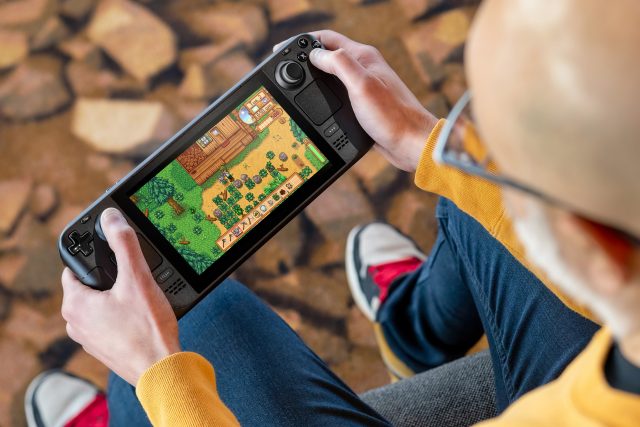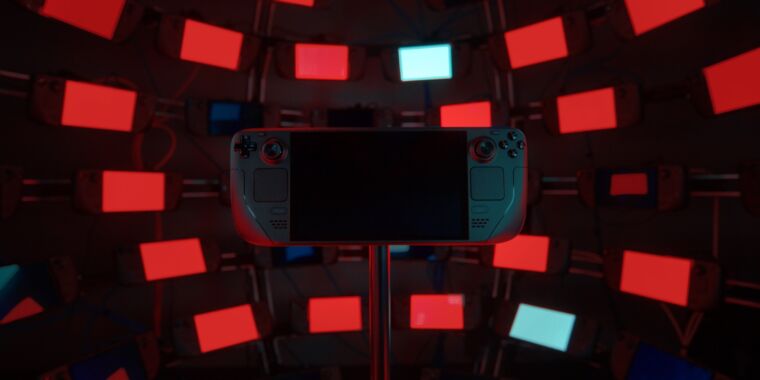
Valve
Given the 2021 launch of Nintendo’s Switch OLED, it might seem a little weird that we’ve had to wait nearly two years after the original Steam Deck launch for today’s announcement of an OLED-equipped version. In interviews surrounding that announcement, though, Valve says an OLED screen was never in the cards for the original Steam Deck, given the timeline involved.
Valve designer Jeremy Selan tells IGN that “the display technology for the HDR display, we kicked that off prior to even having shipped the first [Steam Deck].” Selan added to Rock Paper Shotgun that work on this OLED update started “basically immediately” after the original unit was released.
“We knew we needed a better display, even from day one,” Selan told RPS. “It just takes multiple years, it takes a lot of money.”
“The screen, I think, [is] the biggest example of something we would have shipped in the first-generation model, but we weren’t able to do so because OLED screens with these characteristics in this size just did not exist,” Steam Deck Product Designer Greg Coomer told Eurogamer. “Back then, we really couldn’t engage with a display manufacturer to do exactly what we were after because they didn’t really understand the product category, or who would be buying the screen, or why it would matter. Now that picture has changed and we’re able to get custom work done.”
Coomer echoed a similar sentiment to The Washington Post, saying Valve “just didn’t have the engineering work done or access to the components that we would’ve liked to put in,” for an OLED Steam Deck last year. “There’s definitely real considerations we had around supply and access to components driven by the existing success. Being able to develop that custom screen with prominent display suppliers is only possible because Steam Deck is in the wild, and the category is established.”
Selan expanded on the sourcing timeline a bit with IGN, noting that “technology is always a moving target, and just because something is available today, it often takes 12, 18, 24 months to put them into products.” Selan also summed up the OLED timing issues to Rock Paper Shotgun: “We would have had to delay the original Steam Deck by 12 to 18 months, if we wanted to try to do this type of technology.”
At this point, though, the Steam Deck OLED includes everything “we really wanted to have, all of the things that we have now as really kind of the definitive first-generation Steam Deck,” Valve designer Jay Shaw told IGN. “This is everything on our immediate wishlist that we’d want it to do,” Selan added to IGN.
Years to go for 2.0

We’ve known for a while now that improvements to battery life and screen quality were always Valve’s immediate focus for a near-term Steam Deck upgrade. Now, that the Steam Deck OLED brings just those kinds of improvements, Valve is re-emphasizing that a Steam Deck with more pixel-pushing power is still a few years off.
“Obviously we’d love to get even more performance in the same power envelope, but that technology doesn’t exist yet,” Valve hardware engineer Yazan Aldehayyat told Eurogamer. “That’s what I think we’d call a Steam Deck 2.0.”
The first Steam Deck launched when portable GPU technology had just barely reached the point where it could support the full Steam library, Aldehayyat continued. For a true upgrade that can support high-end games that have launched since the Steam Deck’s debut, he said that “we would love for the trend of perf-per-watt to progress rapidly to do that, but it’s not quite there yet.”
Speaking to Rock Paper Shotgun, Selan said that Valve could have focused its new OLED model APU on performance, rather than battery life. For now, though, “when you look at how those things would balance out, it didn’t quite make sense, I think, for our customers.” The generational improvement Selan says Valve is looking for in a true Steam Deck 2.0—”when we feel like the processor and GPU technology is at a stage where it’s worthy of doing a new performance target”—is still “years away.”
In an interview with Polygon, Valve UX designer Lawrence Yang said Valve wasn’t interested in an iPhone-style annual update cycle for the Steam Deck line. That said, Yang was willing to commit to Valve supporting new Steam Deck models beyond the eventual “Steam Deck 2” and “well into the future.”








